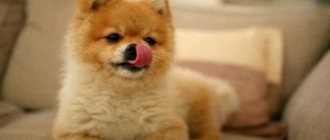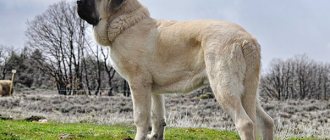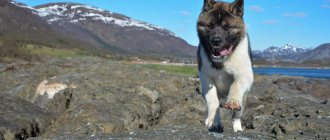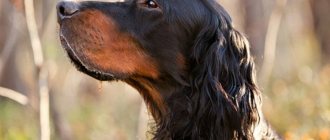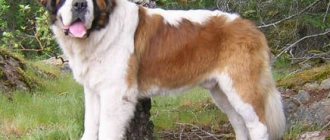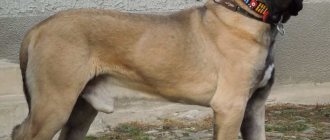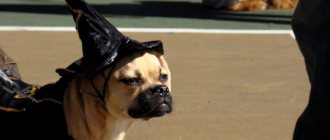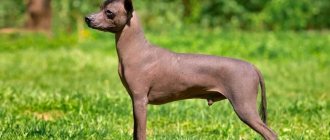Gallery of dog breeds - photos of deerhounds
Where can I buy and how to choose a puppy
Deerhounds are a rare breed. It is better to look for puppies from working parents through representatives of hunting clubs.
In Russia at the moment there is only one nursery engaged in breeding reindeer greyhounds (“Cute Animal”, Moscow). You can also inquire about contacts of individual breeders who do not advertise themselves on the Internet at the hunters’ club, or at the nearest branch of the RKF. These systems are interconnected and will definitely tell you where you can buy a high-breed puppy. If there are no suitable options, you will have to look for a baby outside the Russian Federation, which is also not bad: the appearance of “fresh blood” of a rare breed, which can then be used in breeding, is always welcome.
If you do not understand the breed, take a specialist with you. The best option is to contact an expert who has permission to evaluate the exterior (evaluates the breed at exhibitions). This service is paid, but it’s worth it - you won’t find a better consultant.
Attention! The most optimal age to buy a puppy is 3-4 months. By this time the defects will be more noticeable. At a later age, it is better not to adopt a dog - deerhounds have difficulty getting used to a new owner. Be sure to check what diseases your future pet’s ancestors had. Don't forget about hereditary diseases.
If you plan to hunt with a deer hound, choose kennels that breed working dogs. In this case, the presence of documents confirming the completion of the tests is mandatory.
It is better to adopt a Deerhound puppy at the age of 3-4 months.
History of the Deerhound breed
There is no consensus that could become indisputable evidence of the formation and origin of this breed:
- Some researchers believe that it was the deerhounds that became the descendants of the hunting dogs of the ancient Picts. To prove their theory, they cite hunting scenes depicted on pottery from the 6th century, where dogs similar to deerhounds are depicted next to the hunters.
- According to defenders of another theory, it is a descendant of the Irish wolfhound, which over time acquired a type best suited for hunting deer.
In any case, deerhounds were favorites of the Scottish nobility, who were fond of hunting . Each clan had its own greyhounds, with which the mountaineers hunted. The decrease in the number of deer in Scottish forests has led to the fact that the dog is practically out of work. And the English greyhound has practically replaced its Scottish “colleague”, as it runs faster. Scottish greyhounds are not even used in greyhound racing, as they are inferior to the greyhound and the Australian greyhound.
The new history of Deerhounds dates back to 1825, when lovers of this breed Archibald and Duncan MacNeil began saving this original Scottish breed .
Representatives of this breed came to America, where they were used in hunting coyotes, since deer hunting is strictly prohibited in the United States. And the advent of firearms, and their use in hunting, played a role. Hunting with a greyhound began to lose its popularity: a bullet does the dog’s work, and even more efficiently. Now this type of hunting is a hobby for rare enthusiasts.
Origin of the breed
Deerhounds belong to a subgroup of northern dogs. It is believed that they existed long before they appeared in the Scottish chronicles of the 16th century, from which it follows that they were the favorite dogs of the ruling clans in Scotland. They hunted red deer with them, which the dogs easily killed with the blow of their strong paws and the grip of their powerful jaws. The value of deerhounds, hardy and adapted to mountainous terrain, was so great that the right to have them in personal kennels was sometimes defended in battles.
When deer, and with them other large animals, began to disappear, the demand for this breed of greyhound fell. The war with Great Britain, which occurred in 1745–1746, put a big end to the population. Then almost the entire dog population was destroyed. The ancient breed was on the verge of extinction.
At the beginning of the 19th century. Scottish landowners, the MacNeil brothers, began restoring the breed, in which they were very successful. Walter Scott and Queen Victoria made a great contribution to the popularization of the breed. The fame of passionate deer hunters gradually spread, and in 1892 the breed was officially recognized in Europe. Registered by the English and American Kennel Clubs. In 1955 it was classified by the Federation Cynologique Internationale (FCI).
Description of the Deerhound breed, characteristics
For centuries, the Deerhound hunted with and guarded the leaders of the Scottish clans, so the dog needs constant communication with humans. Representatives of the breed are difficult to raise in a nursery.
The character of the Scottish Deerhound is calm; the dogs are full of inner dignity, energetic, intelligent and, although not aggressive, can be courageous and courageous if necessary.
The value of the Deerhound lies not so much in its rarity, but in its outstanding hunting abilities, which there is practically no place for the surviving representatives of the breed to use. Such a dog can take a deer alone. Hunting with dogs for antlered game is prohibited in the United States, but the deerhound has been successfully used to hunt wolves, coyotes and rabbits. He quickly rushes after any running prey.
Personality of Scottish Deerhounds
A dignified, quiet, calm dog that rarely barks . Smart, loyal, loving - they are excellent companions and friends . Deerhounds love to be around their family as often as possible. They love children, are soft and calm with them . The downside to this nature is that they cannot be watchdogs, as they are friendly.
They usually get along well with dogs of similar size, but small ones may be perceived as prey. They also prey on other small animals, including domestic cats. To avoid attacks on neighboring animals during a walk, the deerhound is kept on a leash.
They have a willful character and need a strong hand and consistent training . Since they are not particularly willing to please their owner, treats are the best motivator. At the same time, finding what they need today is not always easy; what worked yesterday may not work today.
These large dogs require a lot of space and it would be ideal to keep them in a private home with a large yard.
Kennels and crates are not suitable due to the dog's physical limitations and attachment to people. You need to exercise your dog regularly, as Deerhounds are designed for long and difficult races, making them ideal for cycling enthusiasts.
Deerhound breed standard
- DEERHOUND (SCOTTISH DEER HOUND)
- FCI Breed Standard No. 164
- Origin: UK
- FCI classification:
- Group 10: Greyhounds
- No operational tests.
Section 2: Wirehaired
Description
The Reindeer Hound is similar to the Greyhound, only larger and with a coarser coat.
Males at the withers reach 75–80 cm and weigh 40–50 kg, females 70 cm and weigh 35–43. The most common color is gray or sand, with a black mask on the face. But there are many colors, including those with white markings on the chest and paws.
The coat is coarse and hard, 7-10 cm long on the body and neck. On the chest, head and belly the fur is softer and shorter. The tail is straight or curved, covered with hair, almost touching the ground.
Deerhounds have long, flat heads with high-set ears. The ears are small, dark in color, hanging, soft. Eye color ranges from dark brown to light brown with black outlines. Scissor bite.
Nutrition of Scottish Deerhounds
The Deerhound eats the same food as other dogs and is not picky about food. If the diet is balanced, the dog will not get sick. It is advisable to frequently include raw meat in your diet. He will also eat porridge from cereals and meat perfectly. It is advisable to feed the dog twice a day - morning and evening. Despite the fact that the breed is huge, it eats little, and it is not recommended to overfeed it. Of course, we must not forget about fresh water, which should always be available. At the same time, the Deerhound will not be offended at all by the owner if he feeds him only once a day. This is normal for adults. The main thing in such feeding is that the nutrition is well balanced. What we mean here is that your pet must receive all the minerals and vitamins in the required quantities.
Owners of these dogs often wonder what to feed their Deerhound?
According to modern veterinarians, ready-made food is completely balanced, which can be easily purchased both in specialized stores and in supermarkets. This food has all the necessary nutritional properties and provides complete nutrition.
If you become the owner of a very small pet, you need to know what to feed Deerhound puppies. The approximate diet of a puppy under two months of age should include:
- 200-250 grams of beef, including 50 grams of raw minced meat;
- 200-250 grams of cereal (preferably millet, wheat groats or oatmeal);
- 80-100 grams of vegetables (preferably carrots and cabbage);
- 25-40 grams of greens (this can be dill, parsley, lettuce, nettle);
- 500-800 grams of milk or kefir;
- 4 grams of salt;
- 1-2 grams of calcium gluconate.
- To diversify your diet a little, you can periodically replace meat with eggs or cottage cheese at the rate of 100 grams of meat = 1 egg or 300 grams of cottage cheese.
- It’s good if a small puppy’s diet includes chicken meat, just make sure that it doesn’t get any tubular bones. Getting them is fraught with serious intestinal problems. It is better to replace bones with cartilage, they are easier to digest by the stomach.
- In addition, a couple of times a week you can give your puppy boiled fish instead of meat, just remove the sharp fins first.
- Porridge should be the basis of your little pet's diet. It is their presence in the diet that will guarantee that a grown dog will undergo metabolic processes correctly. In addition, a dog accustomed to porridge from childhood will not be picky about food even in adulthood. You need to add vegetables and herbs to the cooked porridge. If the puppy eats boiled vegetables better, there is nothing wrong with that.
- Milk should be a separate dish in the puppy’s diet. You can give it either in its pure form or in the form of milk soups.
- Deerhound puppies under the age of one year need vitamins A and D; in the spring, it is also necessary to give children’s multivitamins, such as Revit or Oligovit.
Choosing a Deerhound puppy
If you are planning to buy a dog of this breed for yourself, be sure to learn a few recommendations that you should carefully study before making your final decision.
First of all, you should decide why you need a Deerhound, and then compare your capabilities with the mandatory conditions for keeping such a dog. If you have found the necessary balance, let's move on to specific recommendations.
- First of all, immediately familiarize yourself with the puppy's detailed pedigree. If you have no experience, take with you a canine specialist who can help you in this specific matter.
- Make sure the dog is already four months old. It is most appropriate to take responsibility for a dog between four months and a year old, since older dogs will require a lot of tinkering, because deerhounds become strongly attached to their owners and slowly wean themselves off them.
- In a conversation with a representative of the manufacturer, ask about possible problems with the current litter , and at the same time find out everything about the previous one. This will help you quickly respond to possible features of the puppy’s development and behavior.
- If you are taking a puppy in order to raise him to be an active hunter, you should pay special attention to the stud dog. If the dog seems slightly overfed and lethargic to you, or, conversely, abnormally hyperactive and skinny, this may indicate problems in the upbringing and maintenance of the individual , which can directly affect the puppy’s instincts and learning ability.
- Carefully study the dog's passport, and if it is missing, it is best to refrain from purchasing it. The passport must indicate all the procedures and vaccinations performed, and your job is to make sure that everything is done according to the standard. For convenience, I recommend using the article Vaccinations for dogs by age: schedule, table.
- At the very end, check that the puppy’s exterior meets the breed standards - for a Deerhound this is FCI (group 10, section 2) No. 164.
Deerhound care and maintenance
Deerhounds are hunting dogs; if a dog is purchased for its intended use, then it must be kept in spartan conditions, as befits hunting dogs. If it is for the family and home, then it is advisable to train the dog from the very beginning and tame it to its place.
Deerhounds love home coziness and comfort. If you don’t show them and accustom them to their place, be prepared that the chair, the sofa, and the bed will be occupied all the time by this far from tiny dog, and during shedding you will have to pick up fur everywhere.
Dogs of this breed have difficulty adapting to apartment life . They are more comfortable in nature, where they can run around to their heart's content. They don't like hot weather. Proper care for a Deerhound is no different from basic care for any other breed of dog.
So how to care for a Deerhound?
- The dog's coat needs weekly regular brushing, and around the ears and muzzle, trimming is required.
- It is necessary to periodically brush his teeth, eyes, ears, and trim his nails.
- The key to your dog's health is quality food, physical activity, having his own place, as well as communication with other dogs and his owner.
These greyhounds are best owned by those who live in their own home.
If your dog walks outside a lot, it is important to ensure that there is a shaded place; the Deerhound does not respond well to heat. If you live in an ordinary apartment and want to get this breed, keep in mind that you will need to provide it with daily exercise in the fresh air.
Deerhound puppies are very active and prefer to spend most of their time on the move; they love to frolic in nature. However, Deerhounds sometimes become lazy as they age, so it is important to remember to take them for a run and let them run around off-leash. It is worth choosing a place for such walks carefully. This must be an area enclosed by a fence or some field away from the road.
Maintenance and care
The Scottish Greyhound does not require much space, so it is convenient to keep it in a city apartment . Although in a private house with a local area.
The dog can live in a spacious enclosure or in a kennel, but if severe frosts strike, it is better to let the deerhound into the house. It is impossible to keep such a freedom-loving creature on a leash. In hot weather, the deerhound should be able to hide from the scorching sun under a canopy, since it is difficult for him in the sun .
Walks should be long, with active games and interesting activities. The greyhound is walked at least 2 times a day , one of the walks should last at least an hour. It is good if during this walk the dog can run freely or exercise with the owner, accompanying the owner during cycling or jogging.
An adult deerhound is fed 2 times a day in small portions. Prone to gaining excess weight, so pay close attention to how much food your dog eats.
He is not picky about food, but respects fresh lean meat and porridge.
The diet should be balanced: include sea fish, cereals, vegetables and fruits, and dairy products. The dog will not refuse premium dry food.
The Deerhound sheds a lot , so it is not recommended to let him lie on the bed or sofa. Brush your dog's coat daily to remove dead hair and prevent tangling and matting. Trimming is required periodically around the face and ears. Ears are cleaned as they become dirty, claws are trimmed if they do not grind down on the asphalt and ground.
Education and training of the Scottish Deerhound
Even beginners have no problems with training, because this is an intelligent and understanding dog . The deerhound remembers commands quickly, but does not like being forced to repeat the same thing over and over again. So be patient and create fun things for your dog while training.
The reindeer greyhound is trained in coursing, running, bikejoring, and is taught to ride a bike or ride a horse.
Sometimes on walks, due to the hunting instinct, a deerhound runs away and begins to chase a cat, squirrel, or bird. This behavior must be stopped from puppyhood.
Breed photo
A selection of photos of the Scottish Reindeer Greyhound.
Add a comment Cancel reply
Vaccinations for Deerhounds
Vaccination is carried out against the following diseases:
- canine distemper or distemper;
- parvovirus enteritis - the causative agent is parvovirus;
- infectious hepatitis - causative agent hepadnavirus;
- parainfluenza;
- rabies;
- leptospirosis;
- coronavirus;
- trichophytosis.
When should a puppy have his first vaccination?
- At 2 months the first vaccination is carried out. After the injection, the puppy should not be washed, overfed or taken outside. Immunity after the first vaccine is developed within 12 days; this period becomes the most dangerous for the baby. A person needs to make a lot of effort to alleviate the puppy’s condition. After the first vaccination, puppies experience increased body temperature, general weakness and diarrhea.
- After 3 weeks, the puppy is given a second vaccination, but with the same vaccine. As a rule, after the second vaccination the dog feels much better, but for 12 days it must be protected from other animals, from drafts and not taken out for walks. After this time, walks are allowed.
- At 6 months of age, the puppy is vaccinated against rabies and a complex vaccine against several diseases. It is forbidden to vaccinate if the dog's teeth are changing. You need to wait until all the teeth are replaced, and then vaccinate the baby.
- At one year of age, the dog is given a comprehensive vaccine.
- Further, once a year the dog should be vaccinated with the same complex vaccine.
How to vaccinate a puppy?
Only a qualified specialist should vaccinate a puppy .
Before vaccination, he must examine the dog, measure its body temperature, and only if everything is normal, give the injection. The vaccine is placed either in the scruff of the neck or in the hip of the dog. The entire list of vaccinations administered by the veterinarian must be recorded in the dog’s passport. It also indicates the date of vaccination; subsequently, the owner himself will know the expected date of the next vaccination.
What to feed: basic principles of feeding the Scottish Reindeer Greyhound
The Deerhound is not picky. The main thing is that the diet is balanced. A good solution may be to feed your greyhound with ready-made food. But their quality should be as high as possible.
Feeding giant deerhounds must be balanced.
Only super-premium and holistic food lines are suitable for the canine giant: Nutra Gold and Artemis, Belcando and Bosch, Arden Grange, Canidae and Acana, Wellness and Chicken Soup. You need to select them based on the age and weight of the dog. There are lines for puppies, juniors (teenagers) and adult dogs. The dosage is calculated according to the instructions printed on the packaging.
You can also feed your deer greyhound regular, self-cooked food. In addition to cereals, the diet must contain meat (beef tripe, offal), fermented milk products (cottage cheese is especially important for a growing body), and vitamin and mineral supplements.
Puppy diet from 2 to 3 months:
- beef – 250 gr.;
- cereal – 250 gr.;
- vegetables, fruits – 100 gr. (onions, garlic, legumes, corn, mushrooms and citrus fruits are prohibited);
- kefir – 0.5 l.;
- cottage cheese – 200 gr.;
- vitamin-mineral complex - according to instructions.
Every other day they give 100 grams. sea fish and soft-boiled egg (alternates). Dairy products should be a separate dish. You cannot mix them with porridge or vegetables.
Scottish Deerhounds in heat
What should a bitch owner know?
- The bitch reaches puberty at 8-10 months;
- duration of estrus is 20-22 days, sometimes up to a month;
- frequency of estrus – 1-2 times a year with an interval of 6-9 months;
- signs of estrus – swelling of the dog’s external genitalia, spotting;
- frequent urination - having to walk more often than usual;
- psychological signs - a change in the dog’s behavior - from aggressive to lethargic;
- perhaps there is a change in appetite and the dog drinks more water;
- often bitches begin to shed before going into heat;
- lick the loop intensively.
How to notice the onset of heat?
You can notice the approach of estrus while walking your dog. Behavior can change, often the dog becomes active, playful and disobedient, or, on the contrary, looks unhappy and lethargic. The bitch makes frequent marks - scent “lures” for male dogs, and urination occurs more frequently. The loop becomes more and more swollen; when pressed, you can see a discharge of light pink or dull pink color. If you notice changes in the dog's behavior, do not be lazy and check the dog every day for the onset of heat by dabbing the bitch's loop with a napkin or toilet paper. Pinkish discharge will be the beginning of estrus - mark this day in your dog’s notebook.
The course of the dog's first heat.
- The first heat in dogs is not the same as the next one.
- It may be shorter or longer than the usual estrus period.
- The bitch has either only weak manifestations of estrus, or, conversely, very heavy discharge.
- The first heat may suddenly stop, and then after some time begin again.
- There may be mucous discharge from the loop, a smell that attracts males, and the estrus itself will begin after some time.
- Try not to miss the start time of the first, and subsequently the second estrus, in order to correctly determine the intervals between estrus and know their timing and duration.
Precautions during estrus.
If you are not interested in getting puppies from a dog, you need to take precautions during heat:
- walk your dog ONLY on a leash: even the most obedient dog these days can simply run away, not paying attention to commands;
- do not allow male dogs to mount the dog: if sexual intercourse begins, it is almost impossible to separate them;
- during a walk, literally DO NOT take your eyes off the dog, even when buying bread in a tent, eliminate or minimize contact with male dogs;
- there is a danger of the dog catching a cold in the cold season, the best way to protect yourself is not to walk for a very long time in cold weather and use dog clothes;
- If your dog lives freely on your territory, then from the moment the estrus begins, lock the dog in an enclosure.
Nutrition
You can feed him commercial food and canned food, but it’s better if you cook for him yourself. In this case, more than half of his diet should be meat. This is a very athletic breed and needs protein to stay in shape. The rest should be vegetables and cereals. Don't forget about dairy products. They are essential for maintaining a healthy metabolism.
Avoid overeating. With a calorie surplus, the dog may begin to gain weight, and this greatly affects the dog’s health.
Deerhound mating
In principle, the female is ready to meet a male and for her first heat, but you can’t breed so early!
The ideal days for mating are considered to be from 11 to 15 from the start of estrus. It is best to breed a female by the age of 2, just like males. Under no circumstances should males be bred before two years of age. Early sexual activity will not improve the health of either the dog or the offspring.
- Before mating, animals need to be given a good walk, but should not be fed. It is better to introduce dogs on neutral territory so that they can get to know each other and run around, and then lead them to the male dog’s territory.
- Matings should always be carried out only in the territory of the dog. Actually, an act of love can also happen during dating, so don’t interfere with the process.
So, you're in male territory. Most likely, no intervention will be required, and the bitch, having played enough with the male, will allow a persistent suitor to mount.
If one of the partners for mating is small in relation to the other, then you can place a pillow under the hind legs or, if the bitch is shorter, place her belly on a bent knee. This advice is more relevant for small breeds. Just don’t try to bend the bitch’s paws so that the dog can reach her.
After ejaculation, mating occurs. The male can be on the bitch or stand with his back to her. The animals will figure it out on their own. However, if the lady tries to break free or lie down, do not allow her, hold her back a little. Also try not to scare the dogs.
It happens that after mating, mating does not occur and the male immediately loses interest in the female.
Be sure to carry out a control mating after 24-48 hours.
Scottish Terrier
The breed was bred to protect the farm from rodents, hunt and scare away burrowing animals. Officially recognized in 1879. Scotch Terriers are stocky, short-legged dogs with a beard, mustache, and eyebrows. Average height 28 cm.
Among Scottish terriers there are dogs of three colors:
- uniformly black or interspersed with white, silvery hair.
- wheat;
- brindle, light hair allowed. All colors allow white spots on the chin and chest.
Scotch Terriers recognize only one owner, but are happy to communicate with all households. They avoid strangers and do not like familiarity. Children are treated differently. Children's liberties are suppressed with light nipping, and they play with pleasure with older children.
Scotties are highly trainable, but their training is sometimes hindered by their innate stubbornness. Scottish Terriers are independent dogs with opinions of their own. If it does not coincide with the owner’s requirements, the dog refuses to follow commands, go for a walk or play.
Scottish Deerhound pregnancy and birth
From the day of the first mating to the birth itself, 56 to 72 days . It is advisable to note the day of mating in order to know how long the dogs are pregnant. Too early and too late births most often lead to the death of the litter, so in both of the above cases it is necessary to seek help from a qualified veterinarian. The gestation period in dogs may be shortened due to the small number of offspring.
Typically, young females produce fewer puppies.
The litter size increases when the dog reaches 3-4 years of age, then decreases again. The duration of pregnancy in dogs is not very long; it is not so easy to determine that a dog is pregnant.
Obvious signs of pregnancy in dogs appear at quite late stages. Neither palpation nor the appearance of the pet at an early stage of pregnancy will tell the owner whether the mated bitch is expecting offspring or not. The first signs concern not so much the external appearance as the mental state, and therefore the behavior of the pregnant bitch. The dog, as a rule, becomes calmer, shows affection more often and demands affection from others. Sometimes the animal may not even seem completely healthy.
If the pregnancy is progressing normally, the specialist can establish pregnancy by palpation in the third week. After a month, the dog’s belly noticeably enlarges, and in the fifth week the mammary glands swell and lighten. Shortly before giving birth, the bitch's belly drops. A characteristic sign of approaching labor is abundant discharge from the loop, yellowish or greenish in color.
Also prepare a “maternity kit” so that everything you need is at hand, it should include:
- old duvet covers or large disposable diapers (60*90), on which the bitch will whelp (disposable diapers are preferable - less washing and more cleanliness);
- a lot of small soft rags ironed with a hot iron from old bedding (to dry puppies);
- sterile gauze wipes (usually unnecessary, the puppy’s mouth is dried with a piece of cloth, into which, in fact, the puppy is received);
- a pen, a notebook, scales and thick woolen threads or ribbons (it is better to use floss, because the bitch simply licks and removes woolen threads);
- afterbirth bowl;
- a box or basin for puppies with a heating pad (wrapped in a diaper) - this is in case the bitch behaves restlessly during childbirth and there is a risk of losing puppies... the best option is a bitch giving birth with puppies at the nipples;
- sterile scissors and a medical clamp (it is not necessary to boil; at the onset of labor, place in a jar with any alcohol);
- milk chocolate bar;
- an antiseptic, preferably a spray (Aluminium, Xidicol, Septonex) for treating the umbilical cord.
And also a puppy resuscitation kit:
- cordiamine to stimulate cardiac activity (a drop on the tongue of a newborn);
- an oxygen canister (to give a weak puppy a chance to breathe), costs about 400 rubles in pharmacies;
- small rubber heating pad;
- a small enema for suctioning mucus from the mouth of a very weak puppy.
As for medications, during a normal birth they will not be needed, and if you had to resort to the help of a veterinarian, then he will have the necessary kit. Just in case, you can keep in stock No-shpu in ampoules, glucose 5% solution for infusion; calcium gluconate (a box, may be useful after childbirth).
You will also need a watch to mark the time of birth of the puppies and a notepad to record the details of the whelping (they will come in handy in the future), with your veterinarian's phone number displayed in a visible place. It's also great to have a scale for weighing newborn puppies. The puppy's birth weight, among other whelping details, should also be recorded in a notebook.
Bitches usually whelp between 58 and 63 days. Large litters are born earlier, and small ones a little later.
In the last days before whelping, you need to monitor the bitch’s body temperature. The normal temperature measured in the anus is about 38.5°C. Two days before giving birth, the bitch's temperature usually drops to 37°C or even lower. But since this does not always happen, you need to be attentive to all other signs of impending whelping. And yet, more often than not, if the temperature remains normal, then the bitch is unlikely to whelp in the next 24 hours.
Before whelping, it is good to give the bitch a mild laxative to help her cleanse her intestines.
It is better if, 2-3 days before the expected birth, you call a veterinarian or clinic, warning in advance about a possible call; in any case, the necessary phone numbers should be in a visible place.
Character
Despite its appearance and general menacing nature, the dog is very friendly and loving to its owners. Although he can be simply restless during a walk, at home he is a lazy and always sleepy couch potato.
He is good with children and may even love them, but you should not get a Deerhound if you have a very small child. Don't worry, he won't hurt him intentionally, but due to his clumsiness, he can easily knock the child down by simply turning around sharply. Gets along with dogs of its own size, but does not treat small ones well. Sooner or later he will perceive them as prey and begin pursuit.
If you think that such a giant can be a good watchman, then you are deeply mistaken. Due to his melancholic nature, he is not capable of attacking or neutralizing anyone. Moreover, he will not even warn about the arrival of uninvited guests; he prefers to ignore all strangers.
They are very willful, so they need a person who, from childhood, will keep them under control. Otherwise, you simply will not be able to restrain his power, and he has plenty of it. The Deerhound must unquestioningly carry out all your commands and clearly know its place.
Related breeds
Greyhound (English greyhound)
The Greyhound is a showy, reserved dog, suitable for apartment living. But if you want to purchase such a pet, you should take into account some breed conditions. There is no need to demand something that, due to its purpose, the dog cannot fulfill. A dog needs upbringing, training and obligatory respect. In this case, love and devotion are guaranteed.
Main characteristics
The table below demonstrates the main characteristics of Reindeer Hounds:
| Purpose | Used for hunting and as a companion |
| Height at withers | Males: 76 cm or more Females: at least 71 cm |
| Weight | Males: 45-46 kg Females: 36-37 kg |
| Body type | Elongated, lean. Streamlined shape allows for high speed |
| Color | Varied: all brown shades, blue-gray, red, fawn, brindle |
| Wool | Wire-like. Being soft and fluffy is considered a vice |
| average life expectancy | 9-10 years |
| Intelligence | High |
| Character | Balanced, non-aggressive |
| Security qualities | None |
| Obedience | Follows all commands unquestioningly, good callability |
Deerhounds are characterized by a lightning-fast reaction, a strong and accurate final throw (catching ability).
Dog nicknames: names for deerhounds
Most people prefer to choose a short, sonorous name for their dog.
You will have to say your dog's name many times a day, and if it is too long, it will be tiring.
When choosing what to name a deerhound, you can follow two methods.
- The first and easiest: open the list of the most suitable names for this breed and choose the one that you like best .
- Second: choose an unusual name from other sources, for example, from mythology or literature, name the dog after your favorite celebrity , or come up with your own exclusive name .
There are many suitable names for deerhound girls:
- Maxi,
- Nega,
- Jena,
- Ellie,
- Maida,
- Tory.
The following names are good for a boy deerhound:
- Caesar,
- Wolf,
- Gray,
- Max,
- Leon,
- Jack.
Origin story
The most common version of the origin says that the Vikings once had a huge dog, which they called Ku. She was a universal animal, guarded housing, hunted, went hiking, and as a result had increased aggressiveness. Subsequently, the dogs were divided into two branches. The larger and heavier ones were used to hunt wolves and wild boars; they were called Irish wolfhounds. It is worth noting that they never grazed livestock. Lighter and faster dogs were found further north and were used to hunt deer, hence the name Deerhound or Scottish deerhound. Dogs were also taken to hunt hares and foxes.
In modern society, the use of greyhounds for their intended purpose is very difficult, especially in England and Europe, where hunting is not encouraged. The difficult situation of preserving working qualities is saved by the possibility of using a greyhound in competitions to chase a mechanical hare.
There are very few deerhounds around the world. For example, at Craft, a worldwide show, just over a hundred dogs are exhibited annually. In Russia there are only a few of them, breeders and lovers of Scottish greyhounds know all representatives of the breed by name.
For this reason, it is impossible to register a national breed club and it is very difficult to buy a puppy.
Choosing a Deerhound puppy
Do not forget that it is best to make a purchase from a trusted breeder.
- Particular attention should be paid to the documents if you are choosing a Deerhound puppy for further participation in exhibitions.
- Remember that the appearance of such a dog must be appropriate. There are fewer requirements for the exterior if your dog is intended for hunting or it is a hound.
- Pay attention to the fact that the pedigree of the show puppy includes show ancestors and, accordingly, the puppy for hunting has hunting ancestors.
- If you choose just a companion, you can choose a representative from any line.
ul>
Health and life expectancy
Representatives of the breed are not long-lived, living on average 10 years .
Deerhounds are prone to the following diseases:
- portosystemic shunt (pathology of the blood vessels of the liver);
- hypothyroidism (pathology of the thyroid gland);
- stomach torsion;
- respiratory allergies;
- cardiomyopathy (heart pathology);
- cystinuria (hereditary kidney disease).
Irish Wolfhound and Deerhound - differences
At first glance, these two breeds may seem similar, but in reality they have little in common. The Deerhound and the Irish Wolfhound differ in character. The first breed is a true greyhound with a strong temperament. They are passionate hunters and can be dangerous to small animals. It is better to get Deerhounds for active people, because the pet needs to regularly get rid of a huge amount of energy. In addition, the following differences are distinguished:
- the Irish are more massive and majestic;
- Deerhounds are a bit fast;
- The wolfhound has a more elongated body;
- Deerhounds do not have a smooth transition from forehead to muzzle;
- the strength of the Irish is much greater.
Irish Wolfhound – colors
Dogs of this breed can be of different colors:
- Irish wolfhound black
; - grey
; - ginger
; - motley
; - wheat
; - white
.
Health
If you watch your dog very carefully, it rarely gets sick. There are diseases to which she is very sensitive, but this does not occur very often. The most common diseases that these dogs suffer from include: cardiomyopathies, hypothyroidism, respiratory allergies, cystinuria, gastric torsion, portosystemic shunt. One of the most dangerous diseases that occurs all over the world is cancer . This breed is prone to developing cancer and therefore needs to be vaccinated in childhood to reduce the risk of developing cancer.
Training
This breed responds very well to all commands. She is easy to train, and therefore the owner does not have problems with her. You should not shout at the dog, as this will make no sense and may make things even worse. It is not recommended to keep her on a leash, as she needs freedom , so it is better to let her run around so that she spends all her energy.
Now this dog plays the role of a companion, but she is still a hunter at heart. It is very good to take her into the forest for walks, where she can run around and have a good rest. You can’t do this often, but at least once a month, as it is also very beneficial for her muscles. A very interesting fact is that puppies should not be forced to run in the first year of their life, as bones are being formed, and this can have a very bad effect in the future.
